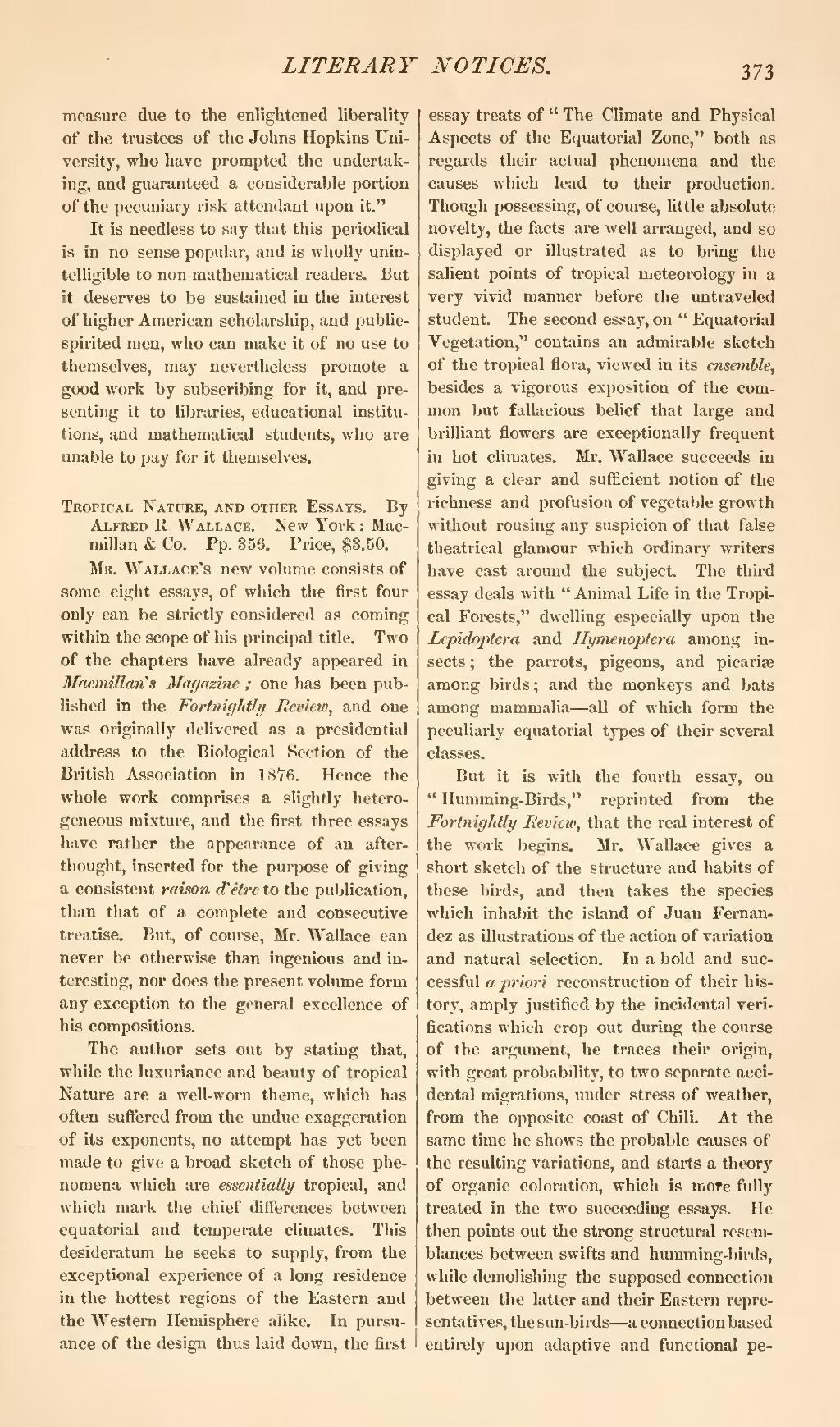measure due to the enlightened liberality of the trustees of the Johns Hopkins University, who have prompted the undertaking, and guaranteed a considerable portion of the pecuniary risk attendant upon it."
It is needless to say that this periodical is in no sense popular, and is wholly unintelligible to non-mathematical readers. But it deserves to be sustained in the interest of higher American scholarship, and public spirited men, who can make it of no use to themselves, may nevertheless promote a good work by subscribing for it, and presenting it to libraries, educational institutions, and mathematical students, who are unable to pay for it themselves.
Tropical Nature, and other Essays. By Alfred R Wallace. New York: Macmillan & Co. Pp. 356. Price, $3.50.
Mr. Wallace's new volume consists of some eight essays, of which the first four only can be strictly considered as coming within the scope of his principal title. Two of the chapters have already appeared in Macmillan’s Magazine; one has been published in the Fortnightly Review, and one was originally delivered as a presidential address to the Biological Section of the British Association in 1876. Hence the whole work comprises a slightly heterogeneous mixture, and the first three essays have rather the appearance of an afterthought, inserted for the purpose of giving a consistent raison d'étre to the publication, than that of a complete and consecutive treatise. But, of course, Mr. Wallace can never be otherwise than ingenious and interesting, nor does the present volume form any exception to the general excellence of his compositions.
The author sets out by stating that, while the luxuriance and beauty of tropical Nature are a well-worn theme, which has often suffered from the undue exaggeration of its exponents, no attempt has yet been made to give a broad sketch of those phenomena which are essentially tropical, and which mark the chief differences between equatorial and temperate climates. This desideratum he seeks to supply, from the exceptional experience of a long residence in the hottest regions of the Eastern and the Western Hemisphere alike. In pursuance of the design thus laid down, the first essay treats of "The Climate and Physical Aspects of the Equatorial Zone," both as regards their actual phenomena and the causes which lead to their production. Though possessing, of course, little absolute novelty, the facts are well arranged, and so displayed or illustrated as to bring the salient points of tropical meteorology in a very vivid manner before the untraveled student. The second essay, on "Equatorial Vegetation," contains an admirable sketch of the tropical flora, viewed in its ensemble, besides a vigorous exposition of the common but fallacious belief that large and brilliant flowers are exceptionally frequent in hot climates. Mr. Wallace succeeds in giving a clear and sufficient notion of the richness and profusion of vegetable growth without rousing any suspicion of that false theatrical glamour which ordinary writers have cast around the subject. The third essay deals with "Animal Life in the Tropical Forests," dwelling especially upon the Lepidoptera and Hymenoptera among insects; the parrots, pigeons, and picarias among birds; and the monkeys and bats among mammalia—all of which form the peculiarly equatorial types of their several classes.
But it is with the fourth essay, on "Humming-Birds," reprinted from the Fortnightly Review, that the real interest of the work begins. Mr. Wallace gives a short sketch of the structure and habits of these birds, and then takes the species which inhabit the island of Juan Fernandez as illustrations of the action of variation and natural selection. In a bold and successful a priori reconstruction of their history, amply justified by the incidental verifications which crop out during the course of the argument, he traces their origin, with great probability, to two separate accidental migrations, under stress of weather, from the opposite coast of Chili. At the same time he shows the probable causes of the resulting variations, and starts a theory of organic coloration, which is more fully treated in the two succeeding essays. He then points out the strong structural resemblances between swifts and humming-birds, while demolishing the supposed connection between the latter and their Eastern representatives, the sun-birds—a connection based entirely upon adaptive and functional pe-

